
The Seneca Falls Convention was the first women's rights convention. It advertised itself as "a convention to discuss the social, civil, and religious condition and rights of woman". Held in the Wesleyan Chapel of the town of Seneca Falls, New York, it spanned two days over July 19–20, 1848. Attracting widespread attention, it was soon followed by other women's rights conventions, including the Rochester Women's Rights Convention in Rochester, New York, two weeks later. In 1850 the first in a series of annual National Women's Rights Conventions met in Worcester, Massachusetts.

The Elizabeth Cady Stanton House in Tenafly, Bergen County, New Jersey, United States, is where Elizabeth Cady Stanton lived from 1868 to 1887, her most active years as a women's rights activist. She had previously lived in Seneca Falls, New York and Boston, Massachusetts.

Amelia Jenks Bloomer was an American newspaper editor, women's rights and temperance advocate. Even though she did not create the women's clothing reform style known as bloomers, her name became associated with it because of her early and strong advocacy. In her work with The Lily, she became the first woman to own, operate and edit a newspaper for women.

The Col. William Kelly House is a historic house located at 36 Tudor Place in Buffalo, New York, United States.

John Graves Cobblestone Farmhouse is an American historic home located at Junius in Seneca County, New York. It is a late Federal style, two-story, three-bay wide side hall structure, with a one-story frame wing. It was built about 1837 and is constructed of irregularly sized and variously colored field cobbles. The house is among the approximately 18 surviving cobblestone buildings in Seneca County.

William H. Burton House, also known as the National Memorial Day Museum, is a historic home located at Waterloo in Seneca County, New York. It consists of a 2+1⁄2-story, three-bay offset front entrance main block with two rear wings. The original 1830s Federal-style residence was modified to its present Italianate style in about 1870 and features a hipped roof and cupola. In 1965, the building was purchased by the Waterloo Library and Historical Society to house collections and memorabilia related to the birth of Memorial Day in Waterloo in 1866.

Aaron Wilson House is a historic home located at Ovid in Seneca County, New York. It is a five bay wide, two story, center hall stone dwelling built about 1835 in the Federal style. Also on the property is a huge, gambrel roofed dairy barn, a machine shed, and frame pumphouse.
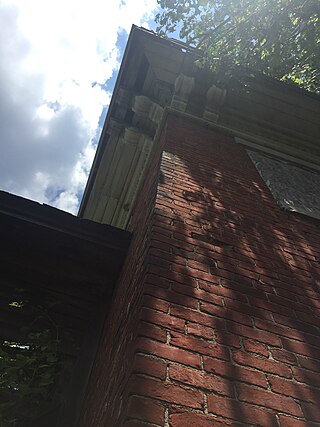
William Hoster House is a historic home located at Fayette in Seneca County, New York. It is a four bay wide, two story, brick dwelling built about 1830 in the Federal style and later modified in the 1850s-1860s in the Italianate style. The hipped roof on the main block is topped by a distinctive octagonal cupola. Also on the property is a small, gable roofed corn crib.
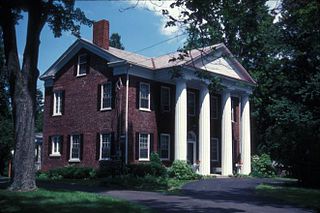
Hunt House is a historic home located at Waterloo in Seneca County, New York. It was built about 1830 and is a two-story brick dwelling with a distinctive pedimented portico supported by four Doric order columns. The home was renovated to its current appearance in the 1920s. The home is notable as the residence of Mrs. Jane C. Hunt who, on July 13, 1848, invited Lucretia Mott, Elizabeth Cady Stanton, Martha Coffin Wright, and Mary Ann M'Clintock to it to plan the First Women's Rights Convention in the United States.
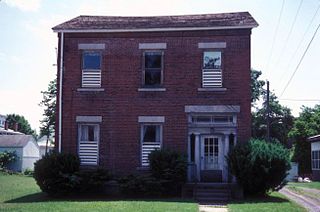
M'Clintock House, also known as the Baptist Parsonage, is a historic home located at Waterloo in Seneca County, New York. It is a two-story, Federal style brick dwelling built in 1833–1836. The home is notable as the residence of Quaker pharmacist Thomas M'Clintock and his wife Mary Ann from 1836 to 1856. On July 16, 1848, the home was the location where the Declaration of Sentiments and other resolutions and speeches were drawn up for the subsequent First Women's Rights Convention.

The William Austin House is a historic house located at 34 Seneca Street in Trumansburg, Tompkins County, New York.
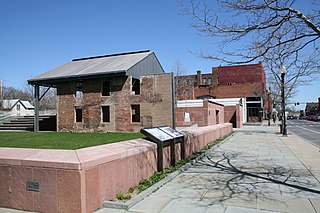
The Women's Rights National Historical Park is a United States National Historical Park in Seneca Falls and Waterloo, New York, United States. Founded by an act of Congress in 1980 and first opened in 1982, the park was gradually expanded through purchases over the decades that followed. It recognizes the site of the 1848 Seneca Falls Convention, the first women's rights convention, and the homes of several women's rights activists.

Hand–Hale Historic District is a national historic district located at Elizabethtown in Essex County, New York. The district contains seven contributing buildings. It encompasses the Hand House and Law Office, the Hale House and Law Office, and dependencies associated with both properties.

The David Mathews House, also known as the State Line House, is a historic house straddling the state line on New York State Route 67 and Vermont Route 67 in Hoosick, New York and Shaftsbury, Vermont. Built about 1800, it is an imposing brick example of Federal architecture. The building is the subject of a number of tales, some of dubious authenticity. It was listed on the National Register of Historic Places in 1979.
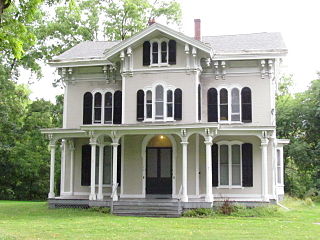
Rombout House is a historic home located at Poughkeepsie, Dutchess County, New York. It was built about 1854 on land that had been part of the original British royal Rombout Patent of 1685 and is a 2+1⁄2-story, three-bay-wide, Hudson River Bracketed architectural style dwelling. It sits on a raised basement and features a central pavilion. It has been owned by Vassar College since 1915.
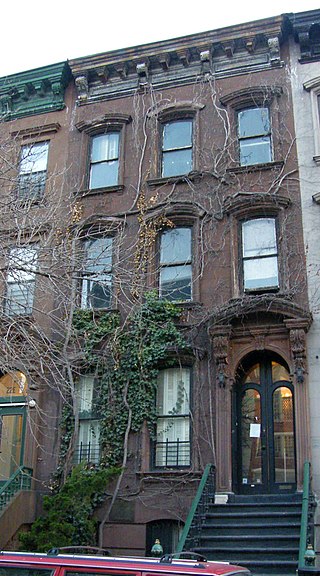
The Langston Hughes House is a historic home located in Harlem, Manhattan, New York City. It is an Italianate style dwelling built in 1869. It is a three story with basement, rowhouse faced in brownstone and measuring 20 feet wide and 45 feet deep. Noted African American poet and author Langston Hughes (1902–1967) occupied the top floor as his workroom from 1947 to 1967.

The Lily was the first U.S. newspaper edited by and for women. It was published from 1849 to 1853 by Amelia Jenks Bloomer (1818–1894) before she sold the newspaper to Mary Birdsall in 1854. While the newspaper initially focused on temperance, it soon broadened its focus to include the many issues of women's rights activists in the 1850s. It grew in its distribution as a result of its discussion of bloomers, a comfortable fashion popularized by Bloomer in the paper.

Lyles-Gudmundson House is a historic landmark home located in Columbia, South Carolina. It was built between 1918 and 1922, and is a two-story Classical Revival style brick dwelling. The home was a wedding gift for Evelyn Robertson Lyles, the daughter of Edwin Wales Robertson. A banker who is credited with much of Columbia's early twentieth century development, Robertson commissioned New York City architect James Brite to design his daughter's home as part of his Wales Garden neighborhood. Brite - a native North Carolinian who died in 1942 - was also the architect of The Braes in Glen Cove, New York and the famous Darlington Mansion near Mahwah, New Jersey.

The Mary Birdsall House is known as the Lauramoore Guest House & Retreat Center and is located in Richmond, Indiana. It was built in 1859 for Thomas and Mary Birdsall, a leading woman's suffragist in Indiana. The Italianate brick-built house is a two-story structure standing at the corner of Northwest Fifth Street and Richmond Avenue. In 1927, the Whitewater Monthly Meeting Religious Society of Friends converted the building to a retirement home, adding on a two-story addition on the west and north sides of the building. Later, the property was given to Earlham College, and it now serves as a guest house and retreat center. It was listed on the National Register of Historic Places in 1999.

Hiram Lay Cobblestone Farmhouse, also known as the Cobblestone House at 1145 Old School House Road, is a historic home located at Tyre in Seneca County, New York. It is a 1+1⁄2-story, five bay, cobblestone farmhouse with Greek Revival style detailing. It has a side gable roof and one-story rear kitchen wing. The roof is topped by a hip roofed cupola. Also on the property is a contributing brick smokehouse. It is the only cobblestone building in Tyre and one of 18 remaining in Seneca County.
























